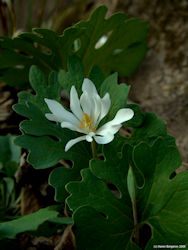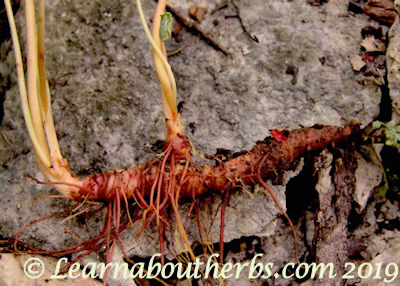
Bloodroot
Authors Deb Jackson & Karen Bergeron (c) 2000 Updated by K. Bergeron 03/12/2019
Sanguinaria canadensis
Bloodroot Herb Use
Bloodroot is used in herbal medicine in very small doses, mainly for bronchial problems and severe throat infections. It should only be used by experienced health professionals. The root is used in many pharmaceuticals, mixed with other compounds to treat heart problems, dental applications (to inhibit plaque), and to treat migraines.
Bloodroot paste is used externally for skin diseases, warts, and tumors. A salve is made and sold for this purpose. People who use the salve claim that tumors come to the surface. The pain is said to be debilitating for some, and it leaves scars. I cannot encourage the use of this salve. Bloodroot is also said to repel insects. The root is used in as an anesthetic, cathartic, emetic, emmenagogue, expectorant, diuretic, febrifuge, sedative, stimulant and tonic.
Other Names: Indian paint, Red Puccoon, Red root, Tetterwort

CAUTION! Use internally with caution, it contains toxic opium-like alkaloids and can cause mucous membrane irritation, an over dose can be fatal, do not use when pregnant or lactating. Bloodroot is not edible. People who use Bloodroot salve as an escharotic to treat skin cancer may think it works, but without a biopsy there is no way to be sure that all, if any, cancer is removed.
Link: Study proves black salve is not the salvation that skin cancer patients hope for.
Bloodroot Habitat and Description
Bloodroot is a North American native perennial herb found growing in shaded, moist, rich woodlands from Quebec south to Florida and west to Kansas. Bloodroot grows to about 6 to 7 inches tall. The pale green, palmate, lobed, basal leaf is wrapped around the flower as it emerges and opens as the flowers blooms. The stem of Bloodroot is round, often orange or red when mature, it is topped by a single white flower with 8 to 12 petals and bright yellow center. The root is a thick, tender, tuber which contains a red juice that stains the skin readily. Gather root when flowers are in bloom. Dry the roots for later use or tincture fresh. Bloodroot is endangered and should be cultivated. Do not harvest from the wild.

How to Grow Bloodroot
Cultivate Bloodroot from seed or root cuttings, prefers light, sandy, moist soil, slightly acidic, shady areas. Bloodroot takes easily to cultivation in shady areas. Plants can be found from ethical cultivators. Again, do not take Bloodroot plants from the woods.
Herbal Recipes
Dye:
Mix 4 tbs. fresh Bloodroot juice in 1 gal. cold water, add 1 tbs. alum as mordant. This preparation will work on most material to achieve a red to orange hue. Wear gloves when handling bloodroot.
History and Folklore
Bloodroot was used as a healing herb extensively by the Indian Medicine Men and Women in some North American tribes. It was also a ritual skin paint, or war paint, and used as dye by others. The red juice expressed from the root makes an excellent die for cloth, yarn, and many other materials and can be used as a wood stain.



